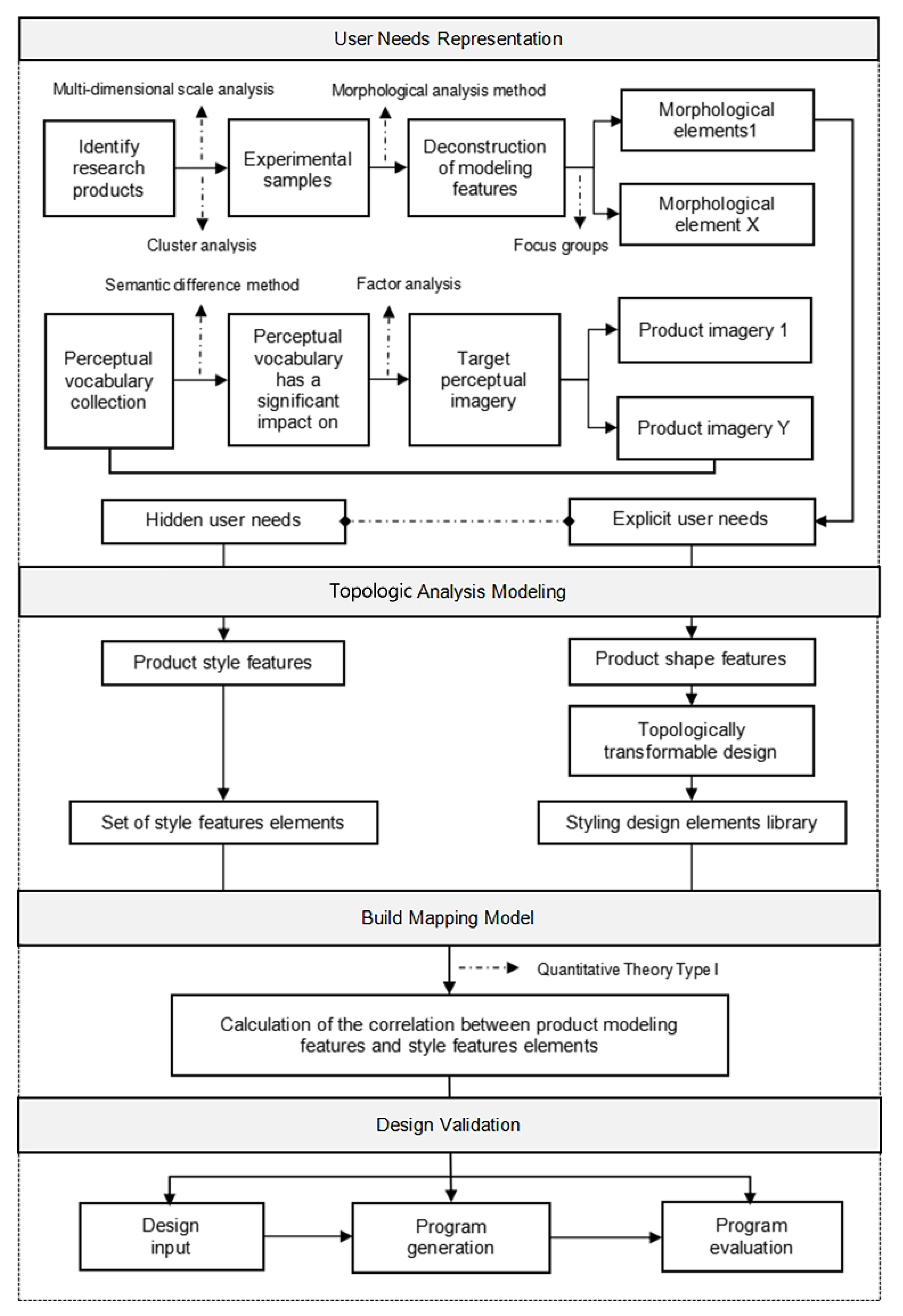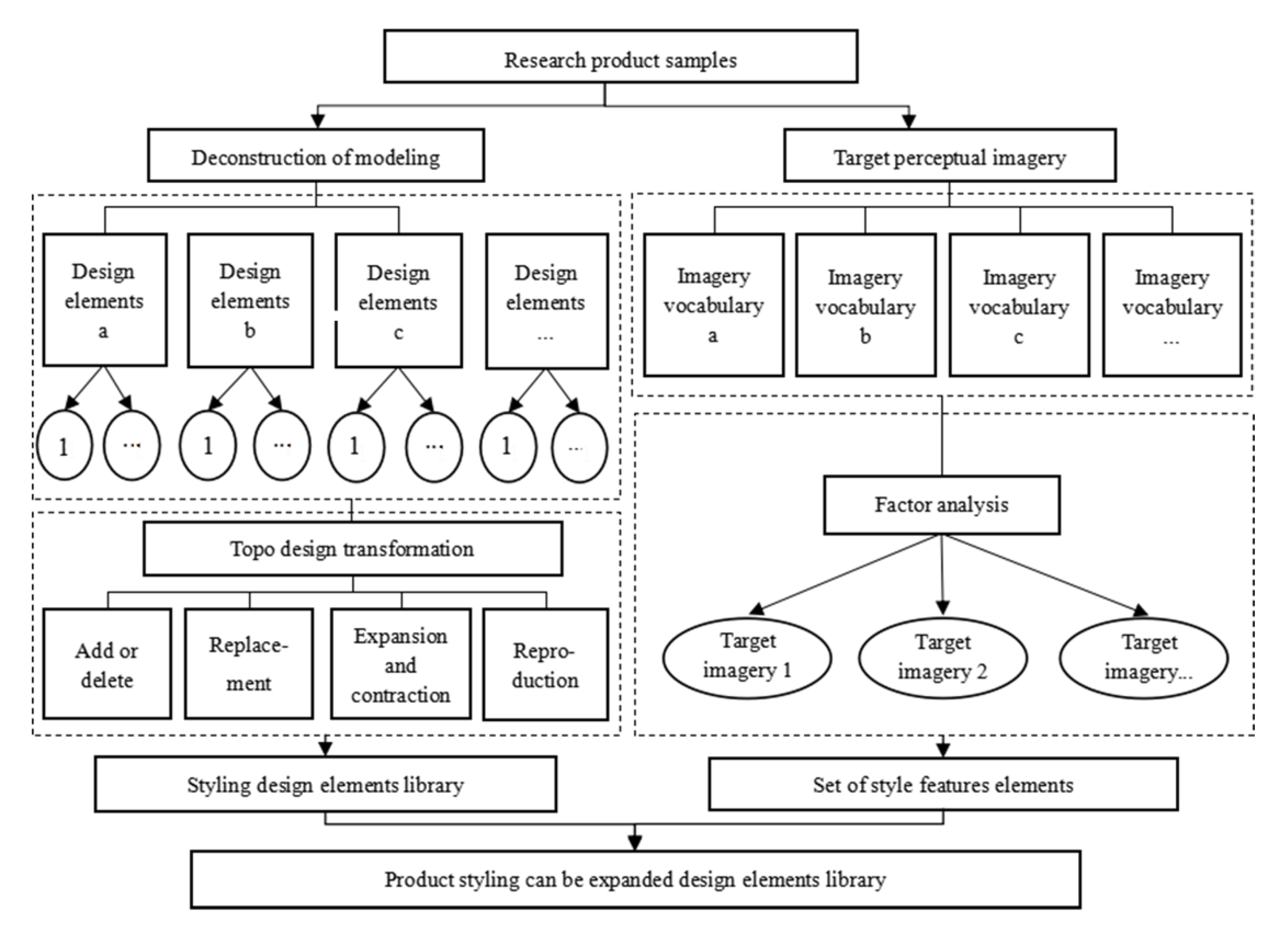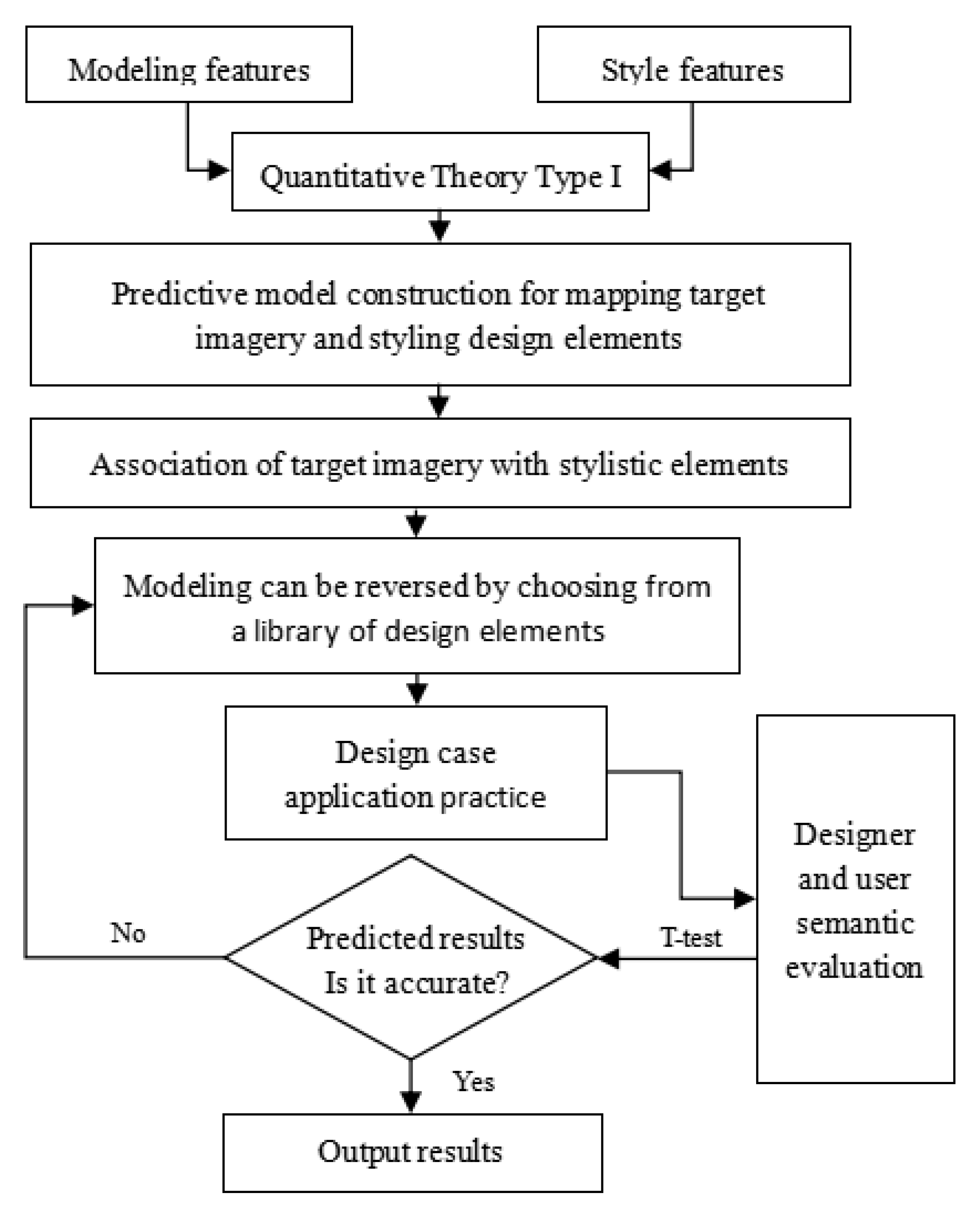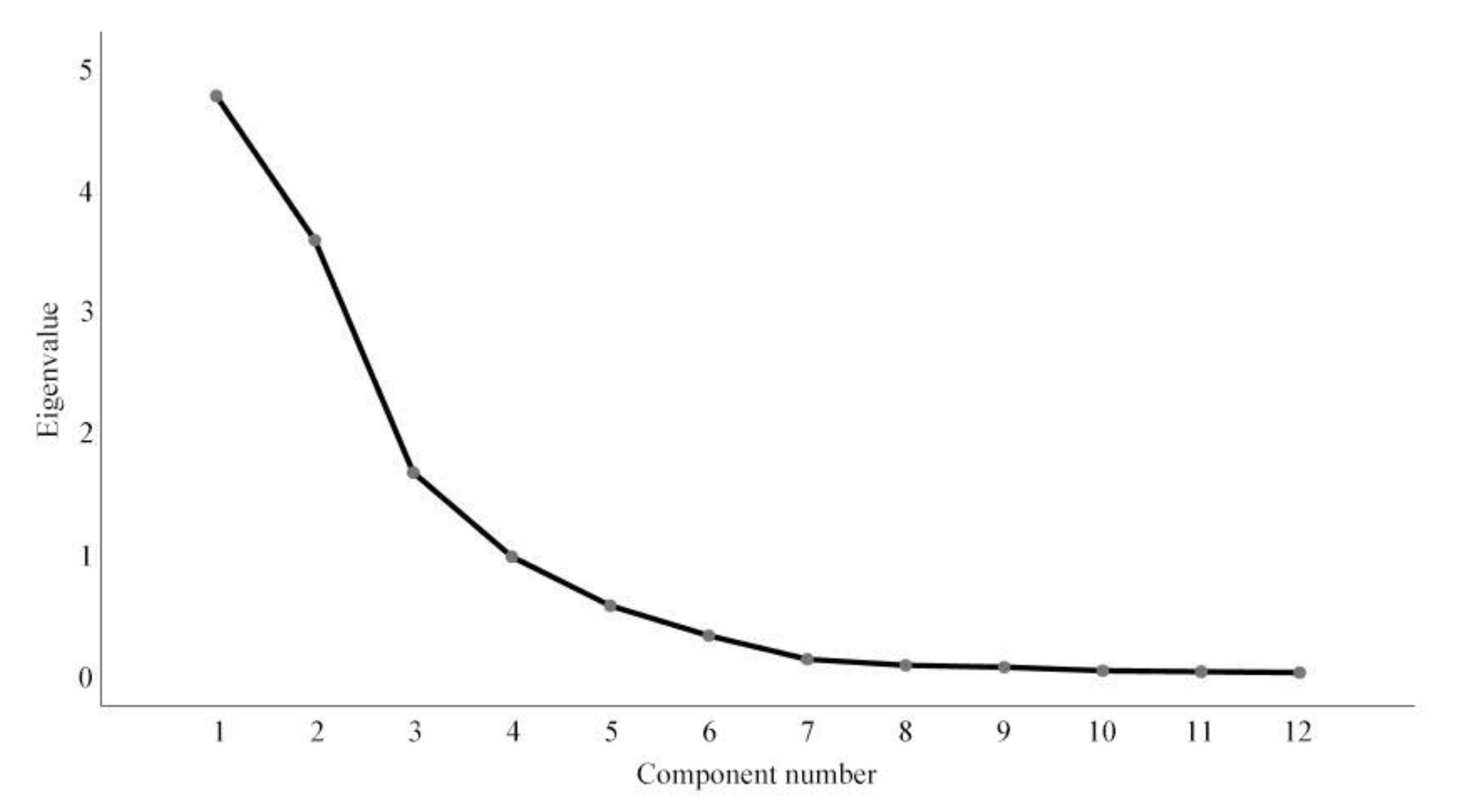Perceptual Quantitative Decision Making and Evaluation of Product Stylable Topology Design
Abstract
1. Introduction
- (1)
- Product modeling design elements are diverse, and their arrangement and combination are particularly rich, which means there is high diversity which can make it difficult to prioritize the problem. The product conveys different psychological feelings to users through external modeling features, and different modeling feature categories will also have certain differential impacts on users, which requires further in-depth research. In addition, specific design parts of the product are not designed for topologically transformable design nor for research based on quantitative analysis.
- (2)
- Users’ needs for products are perceptual, subjective, and ambiguous. Due to these problems, it takes a lot of time to comprehensively and accurately obtain information about the needs of users and transform these needs into product design requirements during the product design process. Additionally, personal subjectivity usually plays a dominant role in the design process. In product design development, the description of the perceptual needs of users is used to guide the subsequent design, which leads to higher costs and lower efficiency of the product design.
2. The Research Method and Process of Product Modeling Topologizable Design
3. Research on Product Modeling Design Based on Topology Theory and Quantitative Theory Type I
3.1. Deconstruction of Modeling Features and Acquisition of Target Imagery
3.2. Product Shape Can Be Topological Design Elements Library
- (1)
- Decompose the transform: , where .
- (2)
- Add and delete transformations: add transformation, ; delete transformation, ㊀ .
- (3)
- Copy transformation: .
- (4)
- Expansion and contraction transformations: , when is an expansion transformation and when is a contraction transformation.
- (5)
- Permutation transformations: .
3.3. Analysis of the Correlation between Product Design Elements and Perceptual Imagery
3.4. Design Solution Evaluation and Validation
4. Example Applications
4.1. Extraction and Characterization of User Requirements
4.1.1. Selection of Target Products and Deconstruction of Modeling Features
4.1.2. Acquisition of Target Perceptual Imagery
4.2. Wine Jug Shape Can Be Topological Design Elements Library
- (1)
- Decomposition transformation
- (2)
- Addition and deletion transformation
4.3. Establishment and Solution of the Quantitative Theory Type I Mapping Model
4.3.1. Solving the Model
4.3.2. Analysis of Results
4.4. Design Solution and Verification
4.4.1. New Wine Decanter Design Scheme
4.4.2. Design Verification
4.4.3. Research on the Application in Different Products
4.5. Research on the Future Work
- (1)
- Product design requires consideration of more complex product features and more implicit user needs to be explored, etc., to facilitate the work of designers.
- (2)
- For the proposed method, we will conduct a larger-scale case study in the future and then improve the proposed method according to the application.
5. Conclusions
- (1)
- Through the deconstruction of product modeling features and the quantification of target perceptual imagery, the explicit and implicit needs of users were characterized. Combining this with the theory of topologizable primitives, the product modeling features, style imagery, and their topologizable values, and unifying these in the same system, a library of topologizable design elements was established for product modeling.
- (2)
- Using the quantitative theory type I, a mapping association model between product modeling features and user target imagery was constructed, and the topizable values of the product modeling design elements were calculated. Quantitative model data were obtained to provide a basis for decision making for later product modeling design.
- (3)
- Study design and validation were conducted using the example of a wine jug product. The results showed that the design output from the data of this prediction model was better than the products already on the market in terms of perceptual imagery evaluation. This further verified the feasibility and effectiveness of the method and system proposed in this paper.
Author Contributions
Funding
Informed Consent Statement
Data Availability Statement
Acknowledgments
Conflicts of Interest
References
- Zhu, J.D.; Su, S.H.; Chen, C.; Liu, G.Y. Improved Interactive Genetic Algorithm for Product Configuration Design. China Mech. Eng. 2018, 29, 2474–2478. [Google Scholar] [CrossRef]
- Li, W.Z.; Yang, X.Y. The Design Method About the Product Form Based on the Function Point Value Setting. Mach. Des. Res. 2019, 35, 175–177, 183. [Google Scholar] [CrossRef]
- Su, J.N.; Kang, Y.J.; Zhang, S.T.; Yang, W.J. Innovative design method of product image styling oriented to cognitive subject. Mod. Manuf. Eng. 2018, 453, 108–113. [Google Scholar] [CrossRef]
- Lu, P.; Hsiao, S.-W.; Wu, F. A Product Shape Design and Evaluation Model Based on Morphology Preference and Macroscopic Shape Information. Entropy 2021, 23, 639. [Google Scholar] [CrossRef]
- Lin, L.; Guo, Z.E.; Yang, M.Q. Current Research Situation and Trend of Product Image-based Modeling Optimization. Packag. Eng. 2020, 41, 65–79. [Google Scholar] [CrossRef]
- Li, Z.; Shi, K.; Dey, N.; Ashour, A.S.; Wang, D.; Balas, V.E.; McCauley, P.; Shi, F. Rule-based back propagation neural networks for various precision rough set presented KANSEI knowledge prediction: A case study on shoe product form features extraction. Neural Comput. Appl. 2017, 28, 613–630. [Google Scholar] [CrossRef]
- Bruno, R.; Luis, C.P. Affective perception of disposable razors: A kansei engineering approach. Procedia Manuf. 2015, 3, 6228–6236. [Google Scholar] [CrossRef][Green Version]
- Ding, M.; Cheng, Y.; Huang, X.G.; Zhao, L.Y. Status and progress of kansei engineering design method. J. Mach. Des. 2020, 37, 121–127. [Google Scholar] [CrossRef]
- Wang, J.; Chen, F.; Qiao, Y.H. Research on evolutionary design of human-machine aided product modeling constrained by target image. J. Mach. Des. 2022, 39, 120–128. [Google Scholar] [CrossRef]
- Yuan, C.F.; Wang, W.L.; Chen, Y. Acquisition and Translation of Customer’s Kansei Requirements Based on Emotional Response in Product Customization Design. J. Ind. Eng. Eng. Manag. 2017, 31, 50–57. [Google Scholar] [CrossRef]
- Shieh, M.-D.; Li, Y.F.; Yang, C.-C. Comparison of multi-objective evolutionary algorithms in hybrid kansei engineering system for product form design. Adv. Eng. Inform. 2018, 36, 31–42. [Google Scholar] [CrossRef]
- Su, J.N.; Chen, Y.H.; Jing, N.; Zhang, X.X. Coupling characteristics study in product image modeling design. J. Mach. Des. 2017, 34, 105–109. [Google Scholar] [CrossRef]
- Li, Y.; Ma, H.J.; Liu, Y.Z.; Wu, Z.H. Kansei image design method of battery electric vehicle based on SPSD evaluation standard. J. Mach. Des. 2019, 36, 134–138. [Google Scholar] [CrossRef]
- Wang, X.T.; Wang, C.; Wang, H.H.; He, R. Modeling Design of Electric Scooter for the Elderly Based on the Theory of Quantification-1 Type. Mach. Des. Manuf. 2020, 7, 165–169. [Google Scholar] [CrossRef]
- Cai, W.; Yang, C.Y. Basic theory and methodology on Extenics. Chin. Sci. Bull. 2013, 58, 1190–1199. [Google Scholar] [CrossRef]
- Zhao, Y.W. A New Method for Scheme Design Based on the Multilevel Rhombus Thought Models. China Mech. Eng. 2000, 11, 684–687. [Google Scholar] [CrossRef]
- Yue, R.T.; Wei, Z.Q. The Correlation of Flight Delays among Multi-airports Based on Matter-element Secondary Extension and Delay Prediction. Sci. Technol. Eng. 2014, 14, 298–302, 315. [Google Scholar] [CrossRef]
- Dou, J.Z.; Li, H.T.; Li, X.S. Problem-oriented industrial designing method on extenics. Procedia Comput. Sci. 2018, 139, 356–363. [Google Scholar] [CrossRef]
- Li, Z.H.; Yang, C.Y. Product extension creative generation method based on reverse design. J. Mach. Des. 2019, 36, 127–133. [Google Scholar] [CrossRef]
- Qin, Z.; Ji, T.; Liu, F.; Liu, Y.H. The Method of Product Design Based on Extension Semantics of National Pattern Primitives. J. Comput. -Aided Des. Comput. Graph. 2021, 33, 1595–1603. [Google Scholar] [CrossRef]
- Gu, P.F.; Xi, W.; Ye, W.P.; Shi, J.; Zhao, J. Extenics matter-element analysis on dilemma problem in HMI design of nuclear power plant. Nucl. Eng. Des. 2019, 350, 176–181. [Google Scholar] [CrossRef]
- Zhang, J.H.; Wang, J.; Dai, J.L.; Song, Y. Product Need-function Mapping Method Based on Extenics Theory. Sci. Technol. Eng. 2017, 17, 166–172. [Google Scholar] [CrossRef]
- Zhao, Y.W.; Zhou, J.Q.; Hong, H.H.; Chen, W.G.; He, L. Overview and prospects of extension design methodology. Comput. Integr. Manuf. Syst. 2015, 21, 1157–1167. [Google Scholar] [CrossRef]
- Xu, W. User-Centered Design (III): Methods for User Experience and Innovative Design in the Intelligent Era. Chin. J. Appl. Psychol. 2019, 25, 3–17. [Google Scholar] [CrossRef]
- Chen, X.F.; Zhu, J.; Zhou, E.M. Research of the customer requirement model for product family based on conjoint analysis and fuzzy clustering. Chin. J. Eng. Des. 2017, 24, 8–17, 26. [Google Scholar] [CrossRef]
- Olaisen, J.; Revang, O. Exploring the performance of tacit knowledge: How to make ordinary people deliver extraordinary results in teams. Int. J. Inf. Manag. 2018, 43, 295–304. [Google Scholar] [CrossRef]
- Zwicky, F. Morphological Astronomy; Springer: Berlin/Heidelberg, Germany, 1948; Volume 68, pp. 121–143. [Google Scholar] [CrossRef]
- Zhu, S.S.; Lou, X.F.; Li, W.J.; Dong, Y.N. Product customization method based on extension design. Comput. Integr. Manuf. Syst. 2020, 26, 2661–2669. [Google Scholar] [CrossRef]
- Chen, T.T. Research on the Design of Small Aircraft Cockpit Display and Control Interface Based on Perceptual Engineering. Master’s Thesis, Shenyang University of Aeronautics and Astronautics, Shenyang, China, 2019. [Google Scholar] [CrossRef]
- Zhang, Y.H.; Liu, H.P.; Yang, X.T. Comparison and Analysis of Landscape Metrics based on Pixel Classification and Object Classification Methods. Remote Sens. Technol. Appl. 2016, 31, 119–125. [Google Scholar] [CrossRef]
- Feng, Q.; Wu, J.X.; Tian, Y.; Yang, Y.P. Research for Form Design of Diet Porcelain based on Shape Grammar. China Ceram. 2019, 55, 77–82. [Google Scholar] [CrossRef]
- Cheng, Y.S.; Xu, X.Q.; Chen, G.Q.; Sun, L.; Wu, J.T. Image prediction model of electric vehicle based on neural network. Comput. Integr. Manuf. Syst. 2021, 27, 1135–1145. [Google Scholar] [CrossRef]
- Given, L.M.; Kuys, B. Memorial design as information creation: Honoring the past through co-production of an informing aesthetic. Libr. Inf. Sci. Res. 2022, 44, 101176. [Google Scholar] [CrossRef]
- Zhang, Y.; Hou, Y.D.; Li, H. Analysis of packaging design elements based on eye tracking technology and quantitation theory. Food Mach. 2019, 35, 113–119. [Google Scholar] [CrossRef]
- Suhaimi, S.N.; Kuys, B.; Barron, D.; Li, N.; Rahman, Z.; Whitfield, A. Probing the Extremes of Aesthetics: The Role of Typicality and Novelty in the Aesthetic Preference of Industrial Boilers. Empir. Stud. Arts 2022, 02762374221094137. [Google Scholar] [CrossRef]
- Liu, Z.H.; Xie, Q.S.; Li, S.B.; Lin, L. User needs matching based on latent semantic analysis and kansei engineering. J. Zhejiang Univ. 2016, 50, 224–233. [Google Scholar] [CrossRef]







| Case Number | Clustering | Distance | Case number | Clustering | Distance |
|---|---|---|---|---|---|
| T1 | 6 | 1.011 | T16 | 6 | 1.73 |
| T2 | 1 | 1.307 | T17 | 1 | 0.483 |
| T3 | 3 | 1.008 | T18 | 5 | 0.875 |
| T4 | 3 | 1.026 | T19 | 4 | 0.681 |
| T5 | 5 | 0.423 | T20 | 1 | 0.713 |
| T6 | 6 | 0.786 | T21 | 2 | 0.934 |
| T7 | 6 | 0.829 | T22 | 4 | 0.783 |
| T8 | 1 | 1.111 | T23 | 6 | 0.458 |
| T9 | 1 | 1.383 | T24 | 6 | 0.759 |
| T10 | 1 | 1.045 | T25 | 6 | 0.981 |
| T11 | 2 | 0.578 | T26 | 3 | 1.525 |
| T12 | 6 | 0.841 | T27 | 5 | 0.591 |
| T13 | 2 | 0.546 | T28 | 6 | 0.521 |
| T14 | 6 | 0.426 | T29 | 5 | 0.363 |
| T15 | 4 | 0.818 | T30 | 6 | 0.939 |
| Representative Samples | Imagery Vocabulary | |||||
|---|---|---|---|---|---|---|
| S1 | S2 | S3 | S4 | … | S12 | |
| T3 | 1.4286 | −0.3571 | −0.7143 | −0.2857 | … | −0.6429 |
| T4 | 0.5714 | −0.1429 | −0.4286 | 0.4286 | … | −0.5714 |
| T5 | 0.2143 | −0.0714 | 0.3571 | −0.2857 | … | −0.1429 |
| T11 | 1.5000 | 0.0000 | −1.0714 | 0.3571 | … | −0.2857 |
| T13 | 1.0000 | 0.0000 | −0.3571 | −0.0714 | … | −0.2143 |
| T14 | 0.6429 | −0.1429 | −0.0714 | −0.5000 | … | −0.2857 |
| … | … | … | … | … | … | … |
| T29 | 0.9286 | 0.5714 | 0.6429 | −1.0714 | … | −0.4286 |
| Ingredients | Extraction of the Sum of Squares of Loads | ||
|---|---|---|---|
| Total | Variance/% | Cumulative/% | |
| 1 | 4.748 | 39.57 | 39.57 |
| 2 | 3.561 | 29.673 | 69.243 |
| 3 | 1.647 | 13.725 | 82.968 |
| Parts | Component Elements | Topologically Transformable | Design Elements |
|---|---|---|---|
| Spout |  | Delete transformation |  |
| Parts | Component Elements | Topologically Transformable | Design Elements |
|---|---|---|---|
| Pot handle |  | Delete transformation |  |
| Parts | Component Elements | Topologically Transformable | Design Elements |
|---|---|---|---|
| Lid |  | Delete transformation |  |
| Scheme | Modeling Features Category | |||
|---|---|---|---|---|
| A pot body | A1 curved shape | A2 curved and straight combined shape | A3 gourd shape | |
 |  |  | ||
| B spout | B1 teapot shape | B2 curved arc | B3 monolithic | |
 |  |  | ||
| C handle | C1 curved shape | C2 curved and straight combined shape | ||
 |  | |||
| D pot lid | D1 curved shape | D2 curved and straight combined shape | D3 alien | D4 none |
 |  |  | x | |
| A1 | A2 | A3 | B1 | B2 | B3 | C1 | C2 | D1 | D2 | D3 | D4 | |
|---|---|---|---|---|---|---|---|---|---|---|---|---|
| T3 | 1 | 0 | 0 | 1 | 0 | 0 | 1 | 0 | 1 | 0 | 0 | 0 |
| T4 | 0 | 1 | 0 | 0 | 1 | 0 | 1 | 0 | 0 | 0 | 0 | 1 |
| T5 | 0 | 0 | 1 | 1 | 0 | 0 | 1 | 0 | 0 | 1 | 0 | 0 |
| T11 | 1 | 0 | 0 | 0 | 0 | 1 | 1 | 0 | 0 | 1 | 0 | 0 |
| T13 | 1 | 0 | 0 | 0 | 0 | 1 | 1 | 0 | 1 | 0 | 0 | 0 |
| T14 | 1 | 0 | 0 | 1 | 0 | 0 | 0 | 1 | 1 | 0 | 0 | 0 |
| T17 | 1 | 0 | 0 | 1 | 0 | 0 | 1 | 0 | 0 | 1 | 0 | 0 |
| T19 | 0 | 1 | 0 | 0 | 1 | 0 | 0 | 1 | 1 | 0 | 0 | 0 |
| T20 | 0 | 1 | 0 | 1 | 0 | 0 | 0 | 1 | 0 | 0 | 1 | 0 |
| T22 | 0 | 1 | 0 | 0 | 1 | 0 | 1 | 0 | 0 | 1 | 0 | 0 |
| T23 | 1 | 0 | 0 | 1 | 0 | 0 | 0 | 1 | 0 | 1 | 0 | 0 |
| T29 | 0 | 0 | 1 | 1 | 0 | 0 | 1 | 0 | 0 | 1 | 0 | 0 |
| Styling Design Elements | Styling Features Category | Score Scope Vx | Category Score Vy |
|---|---|---|---|
| A pot body | A1 | 0.055 | - |
| A2 | - | ||
| A3 | 0.055 | ||
| B spout | B1 | 0.455 | - |
| B2 | −0.036 | ||
| B3 | 0.419 | ||
| C handle | C1 | 1.195 | - |
| C2 | 1.195 | ||
| D pot lid | D1 | 1.945 | −0.370 |
| D2 | - | ||
| D3 | −1.925 | ||
| D4 | 0.020 | ||
| Constants | −0.341 | ||
| R | 0.976 | ||
| R2 | 0.954 |
| V Value | Elegant-Kitsch | Openness-Integrity | Sporty-Steady |
|---|---|---|---|
| Vx | 1.945 | 1.037 | 0.471 |
| Vy | −0.370 | −1.058 | −0.097 |
| V | −0.720 | −1.097 | −0.046 |
| Imagery Vocabulary | Sample | |
|---|---|---|
| 1 | 2 | |
| S1 Modern–Traditional | 0.45 | 0.64 |
| S2 Coordination–Imbalance | −0.39 | −0.71 |
| S3 Elegant–Kitsch | −1.07 | −1.18 |
| S5 Flamboyant–Introverted | 0.26 | 0.79 |
| S6 Light–Bulky | −0.53 | −0.29 |
| S8 Fashionable–Classical | 0.16 | 0.5 |
| S9 Atmosphere–Compact | 0.89 | 0.43 |
| S10 Thick–Spiritual | −0.23 | 0.21 |
| S16 Elegance–Mediocrity | −0.69 | −0.21 |
| S17 Dynamic–Stable | −0.47 | −0.14 |
| S19 Rigid–Soft | 0.03 | 0.5 |
| S20 Gorgeous–Plain | −0.68 | −0.29 |
| T-value | Degree of freedom | p-value |
| 2.209 | 11 | 0.049 |
Publisher’s Note: MDPI stays neutral with regard to jurisdictional claims in published maps and institutional affiliations. |
© 2022 by the authors. Licensee MDPI, Basel, Switzerland. This article is an open access article distributed under the terms and conditions of the Creative Commons Attribution (CC BY) license (https://creativecommons.org/licenses/by/4.0/).
Share and Cite
Wang, Y.; Zhao, Q.; Chen, J.; Wang, W.; Yu, S.; Li, C.; Jia, D. Perceptual Quantitative Decision Making and Evaluation of Product Stylable Topology Design. Processes 2022, 10, 1819. https://doi.org/10.3390/pr10091819
Wang Y, Zhao Q, Chen J, Wang W, Yu S, Li C, Jia D. Perceptual Quantitative Decision Making and Evaluation of Product Stylable Topology Design. Processes. 2022; 10(9):1819. https://doi.org/10.3390/pr10091819
Chicago/Turabian StyleWang, Yi, Qinxin Zhao, Jian Chen, Weiwei Wang, Suihuai Yu, Cunliang Li, and Dongyi Jia. 2022. "Perceptual Quantitative Decision Making and Evaluation of Product Stylable Topology Design" Processes 10, no. 9: 1819. https://doi.org/10.3390/pr10091819
APA StyleWang, Y., Zhao, Q., Chen, J., Wang, W., Yu, S., Li, C., & Jia, D. (2022). Perceptual Quantitative Decision Making and Evaluation of Product Stylable Topology Design. Processes, 10(9), 1819. https://doi.org/10.3390/pr10091819





